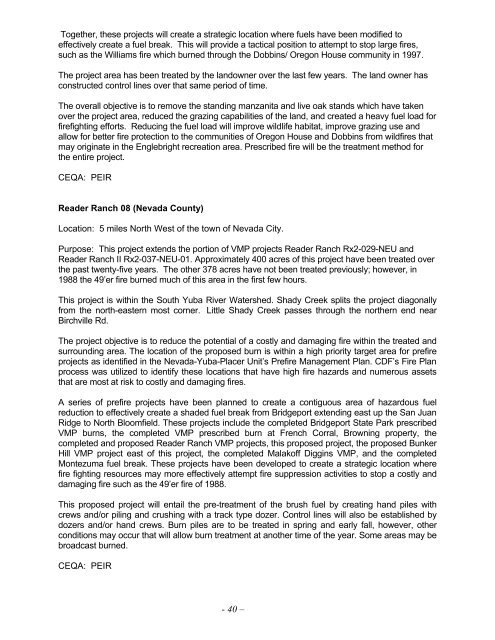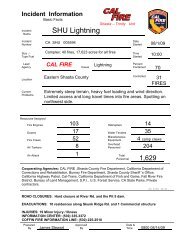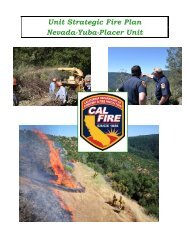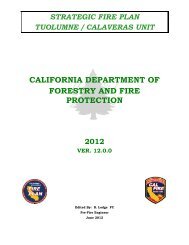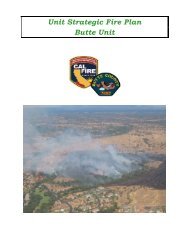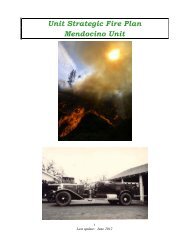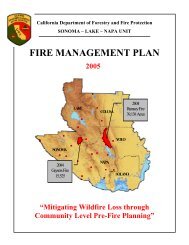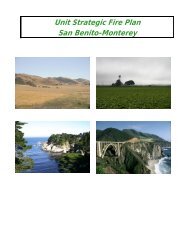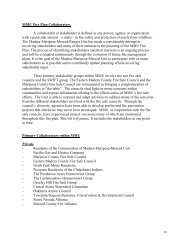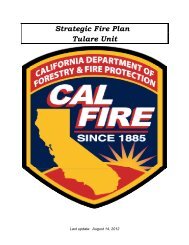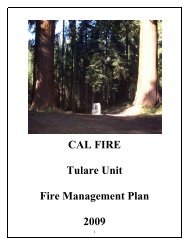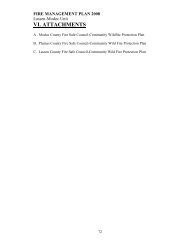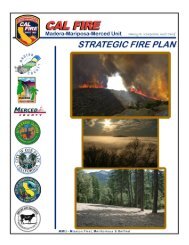Nevada-Yuba-Placer Strategic Fire Plan 2011 - Board of Forestry ...
Nevada-Yuba-Placer Strategic Fire Plan 2011 - Board of Forestry ...
Nevada-Yuba-Placer Strategic Fire Plan 2011 - Board of Forestry ...
Create successful ePaper yourself
Turn your PDF publications into a flip-book with our unique Google optimized e-Paper software.
Together, these projects will create a strategic location where fuels have been modified to<br />
effectively create a fuel break. This will provide a tactical position to attempt to stop large fires,<br />
such as the Williams fire which burned through the Dobbins/ Oregon House community in 1997.<br />
The project area has been treated by the landowner over the last few years. The land owner has<br />
constructed control lines over that same period <strong>of</strong> time.<br />
The overall objective is to remove the standing manzanita and live oak stands which have taken<br />
over the project area, reduced the grazing capabilities <strong>of</strong> the land, and created a heavy fuel load for<br />
firefighting efforts. Reducing the fuel load will improve wildlife habitat, improve grazing use and<br />
allow for better fire protection to the communities <strong>of</strong> Oregon House and Dobbins from wildfires that<br />
may originate in the Englebright recreation area. Prescribed fire will be the treatment method for<br />
the entire project.<br />
CEQA: PEIR<br />
Reader Ranch 08 (<strong>Nevada</strong> County)<br />
Location: 5 miles North West <strong>of</strong> the town <strong>of</strong> <strong>Nevada</strong> City.<br />
Purpose: This project extends the portion <strong>of</strong> VMP projects Reader Ranch Rx2-029-NEU and<br />
Reader Ranch II Rx2-037-NEU-01. Approximately 400 acres <strong>of</strong> this project have been treated over<br />
the past twenty-five years. The other 378 acres have not been treated previously; however, in<br />
1988 the 49’er fire burned much <strong>of</strong> this area in the first few hours.<br />
This project is within the South <strong>Yuba</strong> River Watershed. Shady Creek splits the project diagonally<br />
from the north-eastern most corner. Little Shady Creek passes through the northern end near<br />
Birchville Rd.<br />
The project objective is to reduce the potential <strong>of</strong> a costly and damaging fire within the treated and<br />
surrounding area. The location <strong>of</strong> the proposed burn is within a high priority target area for prefire<br />
projects as identified in the <strong>Nevada</strong>-<strong>Yuba</strong>-<strong>Placer</strong> Unit’s Prefire Management <strong>Plan</strong>. CDF’s <strong>Fire</strong> <strong>Plan</strong><br />
process was utilized to identify these locations that have high fire hazards and numerous assets<br />
that are most at risk to costly and damaging fires.<br />
A series <strong>of</strong> prefire projects have been planned to create a contiguous area <strong>of</strong> hazardous fuel<br />
reduction to effectively create a shaded fuel break from Bridgeport extending east up the San Juan<br />
Ridge to North Bloomfield. These projects include the completed Bridgeport State Park prescribed<br />
VMP burns, the completed VMP prescribed burn at French Corral, Browning property, the<br />
completed and proposed Reader Ranch VMP projects, this proposed project, the proposed Bunker<br />
Hill VMP project east <strong>of</strong> this project, the completed Malak<strong>of</strong>f Diggins VMP, and the completed<br />
Montezuma fuel break. These projects have been developed to create a strategic location where<br />
fire fighting resources may more effectively attempt fire suppression activities to stop a costly and<br />
damaging fire such as the 49’er fire <strong>of</strong> 1988.<br />
This proposed project will entail the pre-treatment <strong>of</strong> the brush fuel by creating hand piles with<br />
crews and/or piling and crushing with a track type dozer. Control lines will also be established by<br />
dozers and/or hand crews. Burn piles are to be treated in spring and early fall, however, other<br />
conditions may occur that will allow burn treatment at another time <strong>of</strong> the year. Some areas may be<br />
broadcast burned.<br />
CEQA: PEIR<br />
- 40 –


